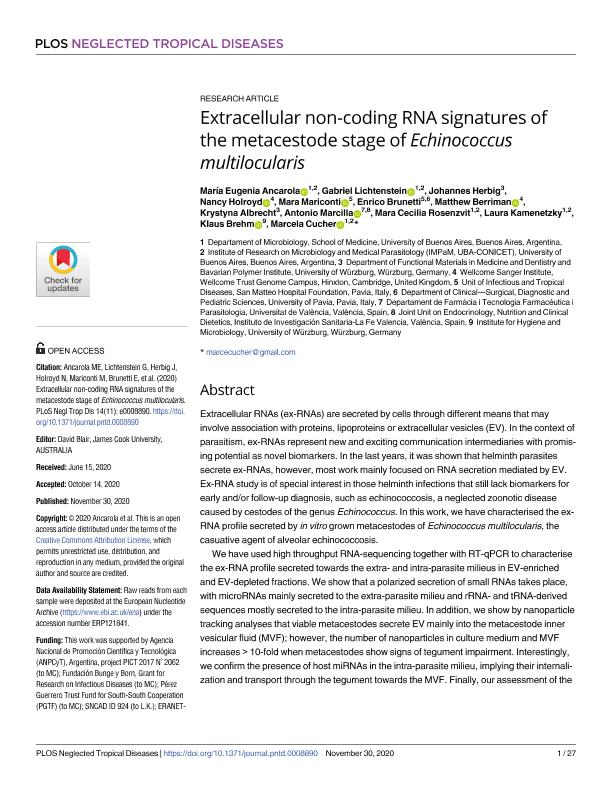Artículo
Extracellular non-coding rna signatures of the metacestode stage of echinococcus multilocularis
Ancarola, María Eugenia ; Lichtenstein, Gabriel
; Lichtenstein, Gabriel ; Herbig, Johannes; Holroyd, Nancy; Mariconti, Mara; Brunetti, Enrico; Berriman, Matthew; Albrecht, Krystyna; Marcilla, Antonio; Rosenzvit, Mara Cecilia
; Herbig, Johannes; Holroyd, Nancy; Mariconti, Mara; Brunetti, Enrico; Berriman, Matthew; Albrecht, Krystyna; Marcilla, Antonio; Rosenzvit, Mara Cecilia ; Kamenetzky, Laura
; Kamenetzky, Laura ; Brehm, Klaus; Cucher, Marcela Alejandra
; Brehm, Klaus; Cucher, Marcela Alejandra
 ; Lichtenstein, Gabriel
; Lichtenstein, Gabriel ; Herbig, Johannes; Holroyd, Nancy; Mariconti, Mara; Brunetti, Enrico; Berriman, Matthew; Albrecht, Krystyna; Marcilla, Antonio; Rosenzvit, Mara Cecilia
; Herbig, Johannes; Holroyd, Nancy; Mariconti, Mara; Brunetti, Enrico; Berriman, Matthew; Albrecht, Krystyna; Marcilla, Antonio; Rosenzvit, Mara Cecilia ; Kamenetzky, Laura
; Kamenetzky, Laura ; Brehm, Klaus; Cucher, Marcela Alejandra
; Brehm, Klaus; Cucher, Marcela Alejandra
Fecha de publicación:
11/2020
Editorial:
Public Library of Science
Revista:
PLoS Neglected Tropical Diseases
ISSN:
1935-2735
Idioma:
Inglés
Tipo de recurso:
Artículo publicado
Clasificación temática:
Resumen
Extracellular RNAs (ex-RNAs) are secreted by cells through different means that may involve association with proteins, lipoproteins or extracellular vesicles (EV). In the context of parasitism, ex-RNAs represent new and exciting communication intermediaries with promis-ing potential as novel biomarkers. In the last years, it was shown that helminth parasites secrete ex-RNAs, however, most work mainly focused on RNA secretion mediated by EV. Ex-RNA study is of special interest in those helminth infections that still lack biomarkers for early and/or follow-up diagnosis, such as echinococcosis, a neglected zoonotic disease caused by cestodes of the genus Echinococcus. In this work, we have characterised the ex-RNA profile secreted by in vitro grown metacestodes of Echinococcus multilocularis, the casuative agent of alveolar echinococcosis. We have used high throughput RNA-sequencing together with RT-qPCR to characterise the ex-RNA profile secreted towards the extra-and intra-parasite milieus in EV-enriched and EV-depleted fractions. We show that a polarized secretion of small RNAs takes place, with microRNAs mainly secreted to the extra-parasite milieu and rRNA-and tRNA-derived sequences mostly secreted to the intra-parasite milieu. In addition, we show by nanoparticle tracking analyses that viable metacestodes secrete EV mainly into the metacestode inner vesicular fluid (MVF); however, the number of nanoparticles in culture medium and MVF increases > 10-fold when metacestodes show signs of tegument impairment. Interestingly, we confirm the presence of host miRNAs in the intra-parasite milieu, implying their internali-zation and transport through the tegument towards the MVF. Finally, our assessment of the detection of Echinococcus miRNAs in patient samples by RT-qPCR yielded negative results suggesting the tested miRNAs may not be good biomarkers for this disease. A comprehensive study of the secretion mechanisms throughout the life cycle of these parasites will help to understand parasite interaction with the host and also, improve current diagnostic tools.
Palabras clave:
RNA
,
multilocularis
Archivos asociados
Licencia
Identificadores
Colecciones
Articulos(IMPAM)
Articulos de INSTITUTO DE INVESTIGACIONES EN MICROBIOLOGIA Y PARASITOLOGIA MEDICA
Articulos de INSTITUTO DE INVESTIGACIONES EN MICROBIOLOGIA Y PARASITOLOGIA MEDICA
Citación
Ancarola, María Eugenia; Lichtenstein, Gabriel; Herbig, Johannes; Holroyd, Nancy; Mariconti, Mara; et al.; Extracellular non-coding rna signatures of the metacestode stage of echinococcus multilocularis; Public Library of Science; PLoS Neglected Tropical Diseases; 14; 11; 11-2020; 1-27
Compartir
Altmétricas



